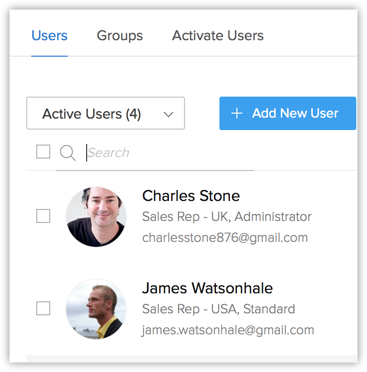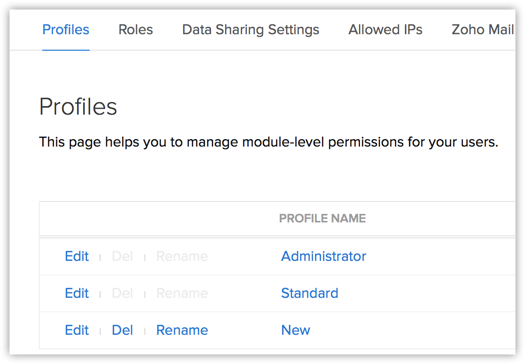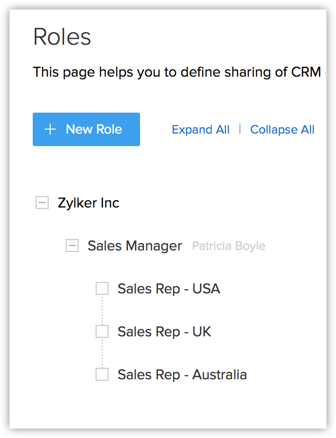Manage Users, Roles, and Permissions
As you proceed with setting up the CRM account, your next step will involve adding users and determining their roles and permissions based on which they will perform specific tasks. A user is the one who manages records within the organization, whether their own or those shared by other users. You can add users based on the edition you have purchased and number of user licences that are allowed. Each user can sign-in to their account with an email address and password. Every user is assigned a role in CRM based on their hierarchial position within the organization. By default the CEO and Manager roles are available, you can add more roles based on your company's structure for example, sales manager, sales rep, etc. and set up a role hierarchy. Creating roles will allow you to provide appropriate level of access to the users depending on their position.
Profile is a collection of permissions that give users access to set of tools and features. Once you have defined the roles of the users you will have better clarity on the type of actions you want them to perform within CRM based on which you can create profiles and assign them to respective users.
There are two types of default profile permissions available:
- Administrators: Users who can access the entire system. There must be at least one Administrator for accessing the entire data and features in your Zoho CRM account. Example: CEO or top officials or top management.
- Standard Users: Users who can access data according to the defined permissions (profiles) and roles in the organization. For example: Sales Managers, Marketing Managers, Support Agents, etc.
Further depending on your businesses needs, you can restrain or permit access to specific features by using the manage profile permission option. Sometimes different team members are needed to pitch in for a particular project or deal. In such cases, you can enable the data sharing rules for an uninterrupted access to a record across teams and departments.
Users, roles and profiles
- Users: Add users to your CRM account and assign them roles and profiles. Note that only after you add a user in your account, will you be able to add new profiles and roles. For the first user that you add, the system defined role (CEO, Manager) and profile (Administrator, Standard) can be assigned. See Also FAQ

- Profiles: Create profiles that define the access permissions to the various CRM modules and features.

- Roles: Also, set up the organization-wide hierarchy by creating Roles and assigning it to users.

Related Articles
Users & Permissions
You can provide access controls to users based on their roles and hierarchy level within your organization. The following are the roles available in Zia Platform that vary with their access levels, as described below. Role Description User Can only ...Manage Roles
In Zoho Recruit, you can set up the organization-wide hierarchy using Roles. Users at a higher hierarchy can always access all the records of at a lower hierarchy. For example, a Senior Recruiter can access all the Recruiters' records whereas ...Create and Manage Roles
In Zoho Workerly, you can set up the organization-wide hierarchy using Roles. Users at a higher hierarchy can always access all the records of at a lower hierarchy. For example, an Agent Admin can access all the records whereas an Agent can access ...Profile Permissions
Profiles in Zoho Recruit help you define permissions for a set of users. For instance, the permissions required for a person from Sales team might differ from the permissions required by a person in the Marketing team. You can define the permissions ...Profile Permissions
Profiles in Zoho Workerly help you define permissions for a set of users. For instance, the permissions required for a person from one Agent in the team might differ from the permissions required by another Agent. You can define the permissions for ...